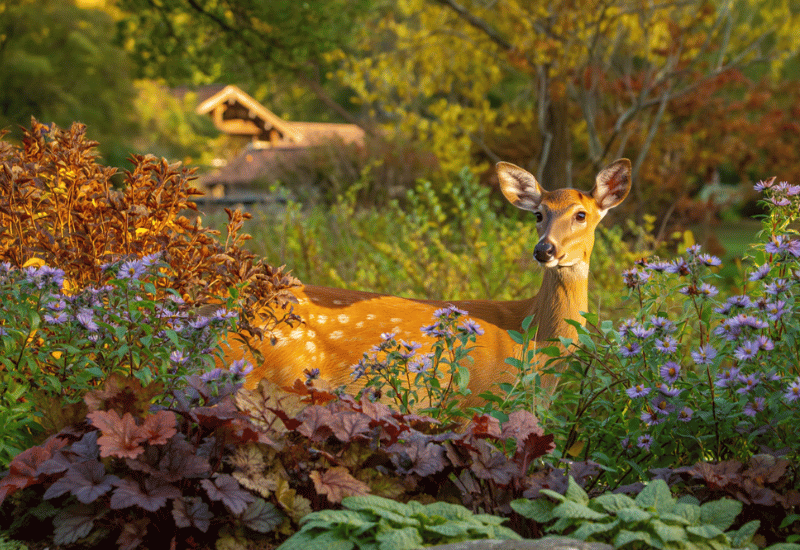
It’s easy to see why everyone plants hostas. They’re calm, beautiful, and make any shady spot feel finished. Those big leaves fill the space, smooth the edges, and bring a quiet kind of order to the garden. You plant them once, and they come back every year without much trouble.
But if you have deer around, you’ve probably learned the hard way — hostas don’t stand a chance. One night is all it takes. You go outside the next morning, and all that green is gone. Just chewed stems and empty soil. It’s discouraging. You work hard to make your garden beautiful, and it keeps getting eaten.

So you start to wonder — is there something that looks just as good, but doesn’t turn into deer food?
Yes, there is.
Native plants can give you that same full, leafy look — but they’re built tougher. They’ve grown here for centuries, adapting to our soil, our weather, and our wildlife. Deer mostly leave them alone. They can handle dry roots, deep shade, and summer heat without extra care. They just know how to live here.
And while they’re at it, they make your garden healthier. Their flowers feed bees and butterflies. Their roots hold water and build better soil. Their leaves give shelter to the small creatures that keep nature in balance.
So if you’re tired of replanting what deer destroy, or you simply want a garden that can take care of itself, start with these ten native plants. They’ll give you everything you loved about hostas — beauty, texture, and calm — only stronger and longer lasting.
1. Giant Trillium (Trillium grandiflorum)

If you love the bold, layered look of hostas but not the deer damage, Giant Trillium is the native upgrade your shade garden needs. In early spring, while most plants are still asleep, it unfurls three broad, sculptural leaves topped with a single pure-white bloom that slowly blushes to pink as it matures. The effect is serene and architectural — a perfect echo of hosta form, but untouched by deer or rabbits thanks to its naturally bitter compounds.
Trilliums thrive in cool, humus-rich soil that stays evenly moist but never soggy. Once established, they return reliably each year, spreading slowly into clumps that lend a timeless woodland feel to shady borders, under trees, or along north-facing foundations. For a natural pairing, grow it alongside Foamflower (Tiarella cordifolia) or Wild blue phlox (Phlox divaricata) for layered color and texture through the woodland season.
Zones: 4–8
Native range: Eastern North America
Size: 8–18 inches tall, 8–12 inches wide (flower stalks up to 3 feet tall)
Light: Partial to full shade
2. Hairy Alumroot (Heuchera villosa)
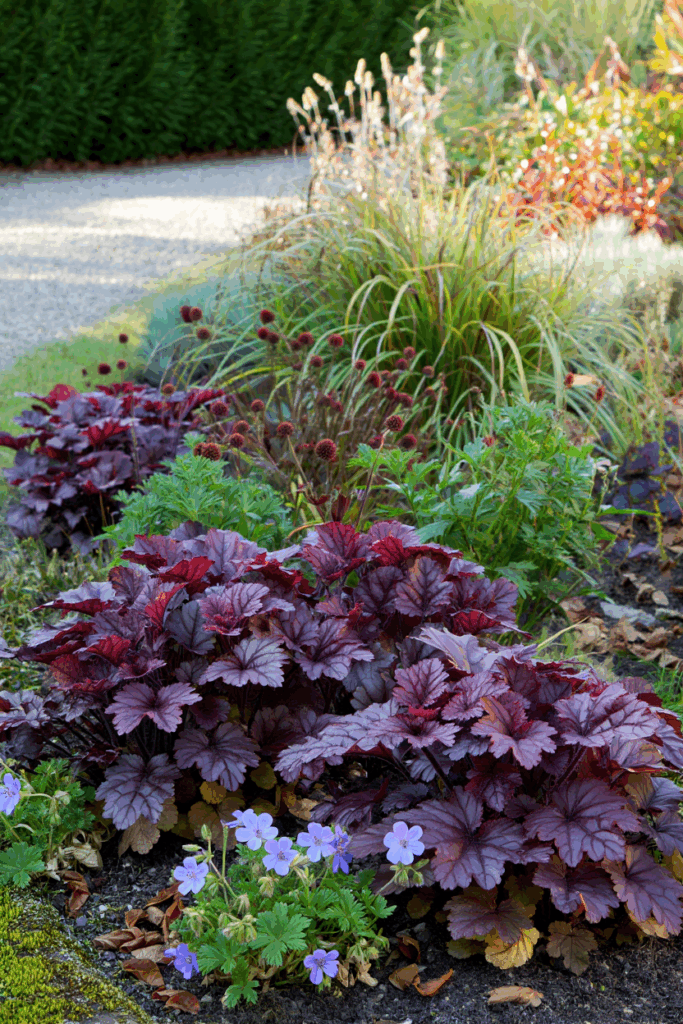
If you’ve spent years fighting deer for your hostas, Hairy Alumroot feels like sweet revenge. This native coral bell gives you the same soft, mounded shape and broad leaves, but its faintly fuzzy texture makes it completely unappealing to browsers. The foliage stays full and fresh all season — no chew marks, no slug holes, no drama. By late summer, tall, wiry stems rise with clouds of delicate white or pink blooms that shimmer in dappled shade and draw in native bees when most other shade plants have gone quiet.
Hairy Alumroot is far tougher than it looks. It thrives in dry, root-filled soil under trees, handles heat and humidity that melt other heucheras, and needs almost no attention once it’s established. For a layered, deer-proof planting, pair it with Foamflower (Tiarella cordifolia) for a spring-to-fall bloom sequence, or with Christmas fern (Polystichum acrostichoides) to add evergreen texture and contrast. The effect is classic hosta abundance — but native, resilient, and totally safe from hungry mouths.
Zones: 4–8
Native range: Eastern and Central United States
Size: 12–18 inches tall, 12–24 inches wide
Light: Partial to full shade
3. Goat’s Beard (Aruncus dioicus)
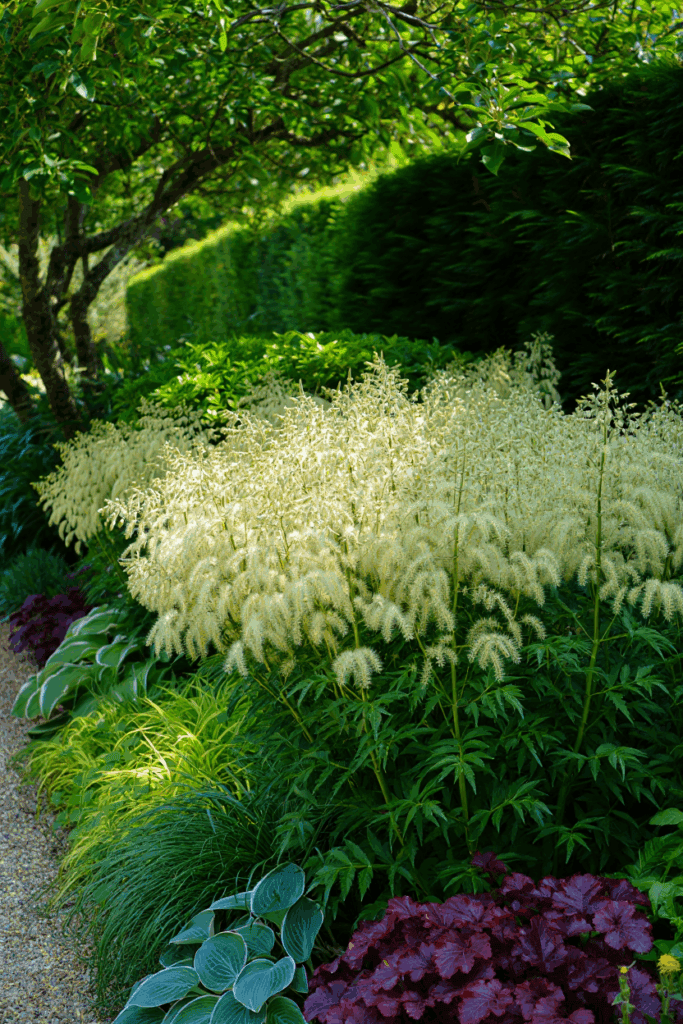
If you love the bold, full-bodied presence of hostas but need something deer-proof, Goat’s Beard earns that space. This native perennial forms dense, upright mounds of finely divided, almost fernlike leaves topped in late spring with massive, creamy-white flower plumes. It brings the same lush volume and clean outline as hostas — but with one key difference: deer won’t touch it. The leaves contain bitter saponins and glycosides, compounds that make the foliage taste unpalatable and mildly toxic to browsers. Even in peak feeding season, Goat’s Beard stands untouched while hostas vanish overnight.
It thrives in moist, rich, well-drained soil and partial shade, and will even tolerate morning sun if kept evenly watered. Deep, fibrous roots help it compete with tree roots and anchor on slopes, making it a low-maintenance structural plant that returns reliably for decades. Combine it with other non-invasive natives like Christmas fern (Polystichum acrostichoides), Foamflower (Tiarella cordifolia), or Wild blue phlox (Phlox divaricata) for a layered, deer-resistant woodland border that feels both polished and ecologically right.
Zones: 3–7
Native range: Eastern and Central North America
Size: 3–6 feet tall, 3–4 feet wide
Light: Partial shade to filtered sun
4. Mayapple (Podophyllum peltatum)

When hostas disappear overnight, Mayapple stands firm — untouched, undeterred, and quietly spectacular. This native woodland perennial emerges in early spring with thick shoots that unfurl into glossy, umbrella-shaped leaves, instantly transforming bare soil into a lush green canopy. Each stem carries one or two leaves, and where they fork, a single white flower hides beneath the foliage — a secret reward for those who take the time to look. By early summer, the flower ripens into a golden fruit that wildlife enjoys, but deer and rabbits avoid completely.
Mayapple thrives in the same shady, humus-rich conditions hostas love, but with far less need for protection or pampering. It forms spreading colonies through underground rhizomes, creating a natural groundcover that feels both wild and deliberate. After a graceful spring show, the foliage yellows and slips away by midsummer — making space for later performers like ferns and woodland asters.
Zones: 3–8
Native range: Eastern North America
Size: 12–18 inches tall, 12–24 inches wide
Light: Partial to full shade
5. Foamflower (Tiarella cordifolia)

If you love how hostas fill a shady spot but can’t stand watching deer mow them down, Foamflower is your quiet fix. It has that same neat, full shape — heart-shaped leaves forming little green cushions — but deer won’t touch it. The leaves carry natural tannins and bitter compounds that make them taste awful to browsers, so your planting actually stays intact through spring.
When everything else is just waking up, Foamflower bursts into life with airy wands of white blooms that hover like mist over the foliage. They last for weeks, drawing early pollinators and giving shady beds a light, romantic lift. The leaves stay lush through summer and even pick up bronzy tones in fall, giving you long, steady color where most shade plants fade out.
It spreads gently over time, never invasively, forming a soft groundcover that protects soil and suppresses weeds. Plant it in rich, humusy soil and partial to full shade — the same spots where hostas once thrived — and enjoy the relief of a shade bed that looks cared-for without needing constant defense.
Zones: 3–8
Native range: Eastern North America
Size: 6–12 inches tall, 12–24 inches wide
Light: Partial to full shade
6. Shooting Star (Dodecatheon meadia)
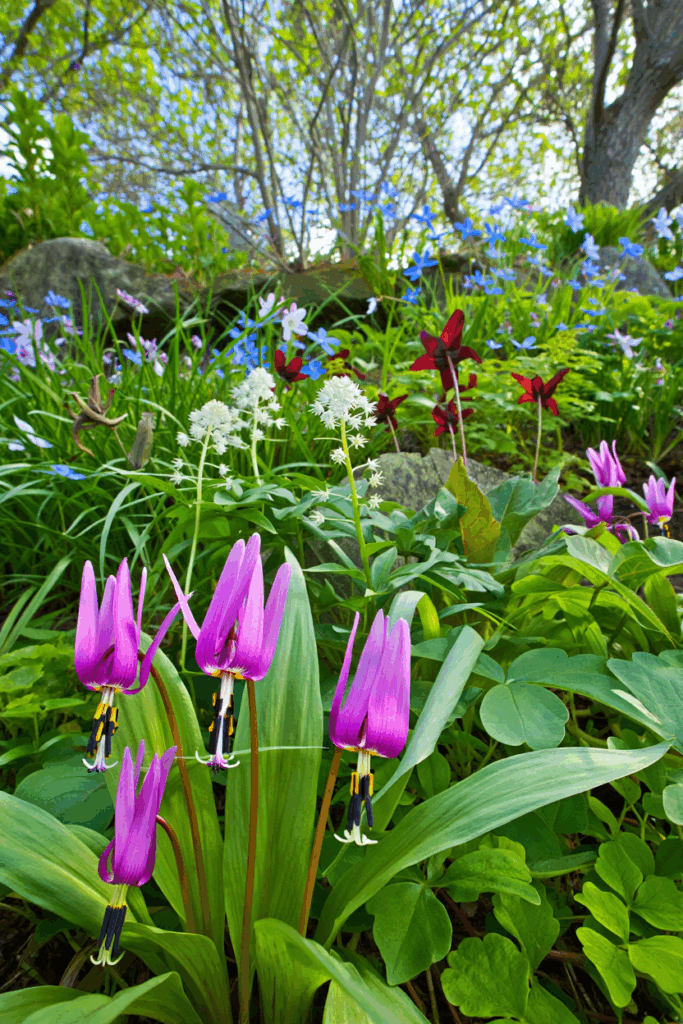
If you’ve ever wished your shade garden had more spring color — and fewer deer bite marks — Shooting Star is the perfect answer. It has the same clean, low rosettes of foliage that hosta lovers appreciate, but instead of sitting still, it puts on one of spring’s most graceful shows. Each flower stalk rises like a wand topped with clusters of reflexed blossoms — pink, lavender, or white — that look like tiny comets mid-flight. Bumblebees adore them, darting up to pollinate before most other blooms have even opened.
Deer and rabbits won’t touch Shooting Star, thanks to bitter plant alkaloids that make it naturally distasteful. It prefers rich, evenly moist, well-drained soil and can handle anything from full shade to full sun as long as moisture stays consistent. The foliage dies back quietly by midsummer, letting other perennials take over — so think of it as a spring specialist, brief but unforgettable. It’s especially lovely massed under deciduous trees or mixed with later performers like Foamflower (Tiarella cordifolia) or Wild geranium (Geranium maculatum) that fill in once it goes dormant.
Zones: 4–8
Native range: Eastern North America
Size: 8–18 inches tall, 8–12 inches wide (flower stalks can reach up to 3 feet tall)
Light: Full sun to full shade (with evenly moist, well-drained soil)
7. Wild Ginger (Asarum canadense)
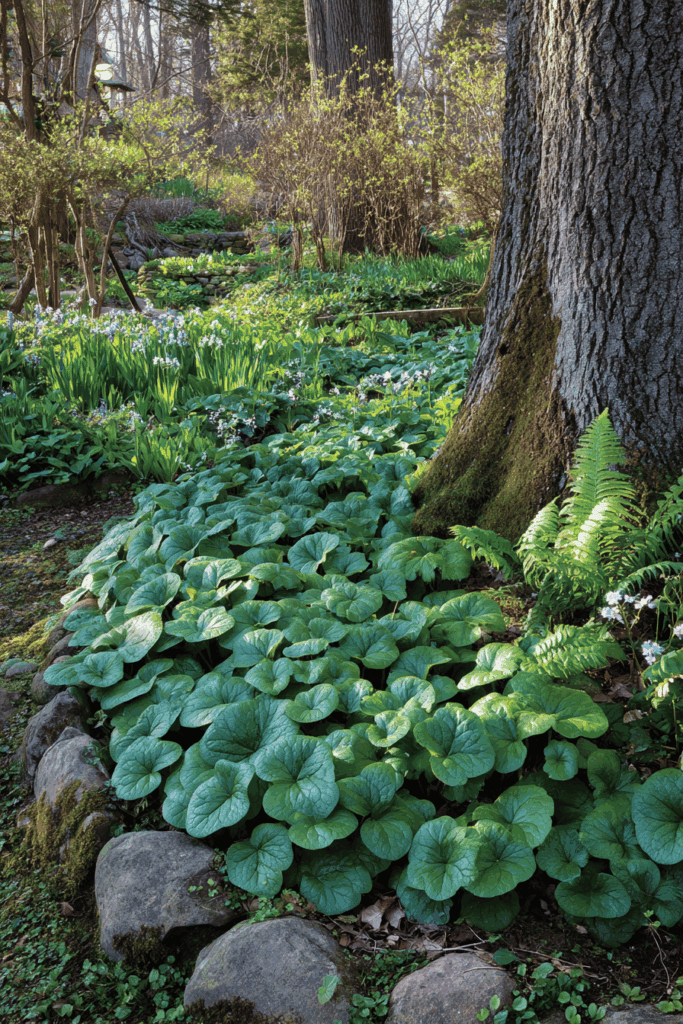
If you’re ready to stop replanting hostas every time deer pass through, Wild Ginger offers the same lush, low, leafy appeal — and it’s one of the toughest deer-proof groundcovers you can grow. Its broad, heart-shaped leaves overlap tightly to form a dense, glossy mat that looks refined yet completely natural. Beneath the foliage, hidden at soil level, lie curious maroon-brown flowers shaped like little jugs — a secret only visible if you peek under the leaves.
Deer and rabbits steer clear of Wild Ginger because its foliage contains aristolochic acids and other compounds that make it intensely bitter and slightly aromatic. That same spicy scent once made it a popular flavoring herb among early settlers (though it’s not edible). This chemical defense, along with the plant’s thick texture, makes it one of the most reliable hosta substitutes in shade gardens plagued by browsing.
Wild Ginger thrives in humus-rich, evenly moist soil and deep or dappled shade. Once established, it forms a living mulch that suppresses weeds, conserves moisture, and adds that same “carpeted” look hostas provide — only evergreen in milder climates and far less maintenance. Combine it with Foamflower (Tiarella cordifolia) or Christmas fern (Polystichum acrostichoides) for an all-native, deer-resistant ground layer that feels both polished and permanent.
Zones: 3–8
Native range: Eastern North America
Size: 6–8 inches tall, 12–18 inches wide
Light: Partial to full shade
8. Bigleaf Aster (Eurybia macrophylla)

If your hostas keep getting chewed to the ground, Bigleaf Aster offers the same broad, leafy texture — but with real staying power. This native perennial pushes out large, heart-shaped leaves in spring, forming a full, layered mound that looks lush even in deep shade. Deer and rabbits leave it completely alone thanks to bitter aromatic oils and coarse foliage, which make it one of the most reliable “hands-off” plants for woodland borders.
By late summer, tall stems rise above the foliage with clusters of soft lavender-blue blooms that light up shaded beds and feed native bees and butterflies when nectar sources start to dwindle. The combination of early-season foliage and late-season flowers gives it a rare dual role: groundcover and pollinator magnet in one.
Bigleaf Aster thrives in partial shade and average, well-drained soil, even under tree roots or in dry woodland edges where most perennials fail. Over time, it forms sturdy colonies that hold the ground, resist browsing, and give your garden that same hosta-like fullness — just without the heartbreak.
Zones: 3–8
Native range: Eastern North America
Size: 18–36 inches tall, 24–36 inches wide
Light: Partial shade to filtered sun
9. Allegheny Spurge (Pachysandra procumbens)

If deer have made a habit of trimming your hostas, Allegheny Spurge is the low-growing native that finally resists them. It fills the same visual role — broad, glossy foliage that carpets the shade — but deer and rabbits leave it alone thanks to its tough, leathery texture and faintly aromatic leaves. In early spring, before the new leaves emerge, it sends up short spikes of fragrant white flowers close to the ground, one of the first signs of life in the shade garden.
Unlike its invasive Asian cousin (Pachysandra terminalis), this North American species spreads slowly and politely by rhizomes, never running rampant. It’s remarkably adaptable once established — thriving in dry, root-filled soil under oaks or maples where most perennials struggle. The marbled foliage holds through winter in milder climates and refreshes with new growth each spring, creating an evergreen-like base that looks ordered and intentional year-round.
If hostas collapse in your dry shade, this plant doesn’t just replace them — it outlasts them.
Zones 5–9
Native range Southeastern United States
Size 6–10 inches tall, 12–24 inches wide
Light Partial to full shade
10. Coral Bells (Heuchera villosa, H. americana)
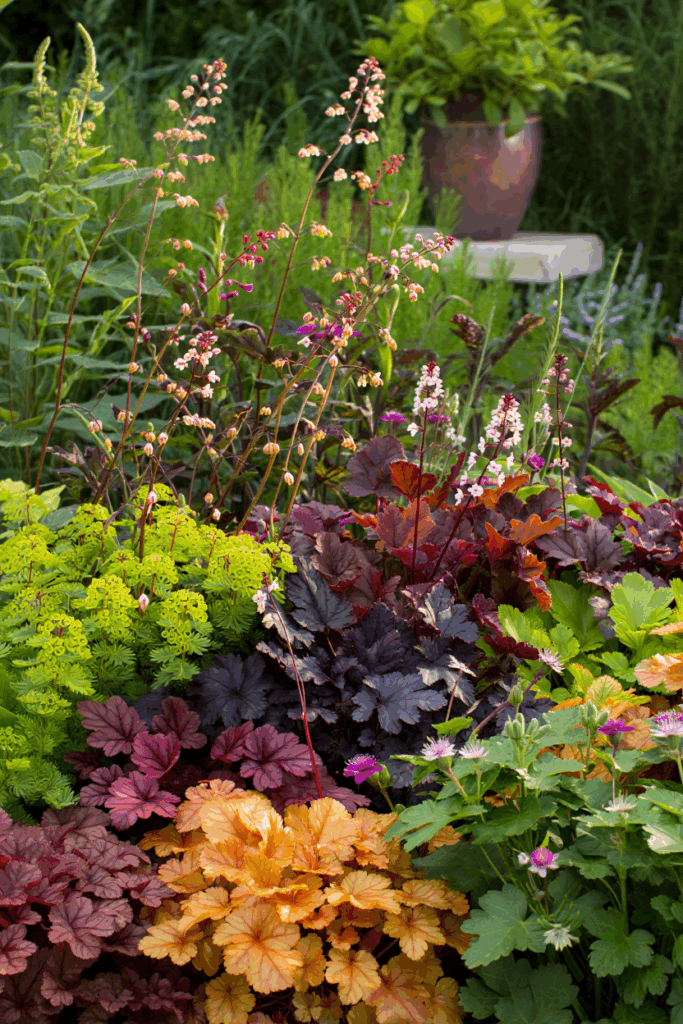
If you’re done watching deer shred your hostas, start planting Coral Bells instead. These native perennials give you the same lush, rounded shape and bold foliage — but deer want nothing to do with them. The leaves are lightly fuzzy and bitter-tasting, a natural deterrent that keeps them looking perfect without any effort from you.
Heuchera villosa ‘Autumn Bride’ is a workhorse for dry shade, with big lime-green leaves and tall wands of creamy flowers that appear just when the rest of the shade garden fades. In cooler regions, H. americana ‘Green Spice’ offers silvered leaves with plum veins that light up dark corners. Both species handle root competition and heat better than hostas ever could.
If you want a pairing that actually lasts, grow them with Christmas fern or Foamflower. The fern adds evergreen structure while Foamflower fills in around the base with spring bloom. It’s a combination that looks designed, stays full through every season, and never needs rescuing from hungry deer.
Zones 4–8
Native range Eastern and Central North America
Size 12–18 inches tall, 12–24 inches wide
Light Partial to full shade

Written By
Amber Noyes
Amber Noyes was born and raised in a suburban California town, San Mateo. She holds a master’s degree in horticulture from the University of California as well as a BS in Biology from the University of San Francisco. With experience working on an organic farm, water conservation research, farmers’ markets, and plant nursery, she understands what makes plants thrive and how we can better understand the connection between microclimate and plant health. When she’s not on the land, Amber loves informing people of new ideas/things related to gardening, especially organic gardening, houseplants, and growing plants in a small space.
